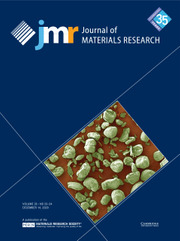Crossref Citations
This article has been cited by the following publications. This list is generated based on data provided by
Crossref.
Zamanzade, Mohammad
Vehoff, Horst
and
Barnoush, Afrooz
2014.
Cr effect on hydrogen embrittlement of Fe3Al-based iron aluminide intermetallics: Surface or bulk effect.
Acta Materialia,
Vol. 69,
Issue. ,
p.
210.
Pathak, Siddhartha
Riesterer, Jessica L.
Kalidindi, Surya R.
and
Michler, Johann
2014.
Understanding pop-ins in spherical nanoindentation.
Applied Physics Letters,
Vol. 105,
Issue. 16,
Xia, Y.Z.
Bei, H.
Gao, Y.F.
Catoor, D.
and
George, E.P.
2014.
Synthesis, characterization, and nanoindentation response of single crystal Fe–Cr–Ni alloys with FCC and BCC structures.
Materials Science and Engineering: A,
Vol. 611,
Issue. ,
p.
177.
de Diego-Calderón, I.
De Knijf, D.
Monclús, M.A.
Molina-Aldareguia, J.M.
Sabirov, I.
Föjer, C.
and
Petrov, R.H.
2015.
Global and local deformation behavior and mechanical properties of individual phases in a quenched and partitioned steel.
Materials Science and Engineering: A,
Vol. 630,
Issue. ,
p.
27.
Wu, D.
Morris, J.R.
and
Nieh, T.G.
2015.
Effect of tip radius on the incipient plasticity of chromium studied by nanoindentation.
Scripta Materialia,
Vol. 94,
Issue. ,
p.
52.
Gao, Yanfei
and
Bei, Hongbin
2016.
Strength statistics of single crystals and metallic glasses under small stressed volumes.
Progress in Materials Science,
Vol. 82,
Issue. ,
p.
118.
Derlet, P. M.
and
Maaß, R.
2016.
Critical stress statistics and a fold catastrophe in intermittent crystal plasticity.
Physical Review E,
Vol. 94,
Issue. 3,
Derlet, P. M.
and
Maaß, R.
2016.
The stress statistics of the first pop-in or discrete plastic event in crystal plasticity.
Journal of Applied Physics,
Vol. 120,
Issue. 22,
Weaver, Jordan S.
Priddy, Matthew W.
McDowell, David L.
and
Kalidindi, Surya R.
2016.
On capturing the grain-scale elastic and plastic anisotropy of alpha-Ti with spherical nanoindentation and electron back-scattered diffraction.
Acta Materialia,
Vol. 117,
Issue. ,
p.
23.
Xia, Yuzhi
Gao, Yanfei
Pharr, George M.
and
Bei, Hongbin
2016.
Single versus successive pop-in modes in nanoindentation tests of single crystals.
Journal of Materials Research,
Vol. 31,
Issue. 14,
p.
2065.
Weaver, Jordan S.
Pathak, Siddhartha
Reichardt, Ashley
Vo, Hi T.
Maloy, Stuart A.
Hosemann, Peter
and
Mara, Nathan A.
2017.
Spherical nanoindentation of proton irradiated 304 stainless steel: A comparison of small scale mechanical test techniques for measuring irradiation hardening.
Journal of Nuclear Materials,
Vol. 493,
Issue. ,
p.
368.
Schuessler, B.J.
Wo, P.C.
and
Zbib, H.M.
2018.
The influence of grain boundaries and grain orientations on the stochastic responses to low load nanoindentation in Cu.
Materials Science and Engineering: A,
Vol. 715,
Issue. ,
p.
226.
Weaver, Jordan S.
Sun, Cheng
Wang, Yongqiang
Kalidindi, Surya R.
Doerner, Russ P.
Mara, Nathan A.
and
Pathak, Siddhartha
2018.
Quantifying the mechanical effects of He, W and He + W ion irradiation on tungsten with spherical nanoindentation.
Journal of Materials Science,
Vol. 53,
Issue. 7,
p.
5296.
Guo, Tingting
Siska, Filip
Cheng, Jun
and
Barnett, Matthew
2018.
Initiation of basal slip and tensile twinning in magnesium alloys during nanoindentation.
Journal of Alloys and Compounds,
Vol. 731,
Issue. ,
p.
620.
Khosravani, Ali
Morsdorf, Lutz
Tasan, Cemal Cem
and
Kalidindi, Surya R.
2018.
Multiresolution mechanical characterization of hierarchical materials: Spherical nanoindentation on martensitic Fe-Ni-C steels.
Acta Materialia,
Vol. 153,
Issue. ,
p.
257.
Guglielmi, Paula O.
Ziehmer, Markus
and
Lilleodden, Erica T.
2018.
On a novel strain indicator based on uncorrelated misorientation angles for correlating dislocation density to local strength.
Acta Materialia,
Vol. 150,
Issue. ,
p.
195.
Maaß, R.
and
Derlet, P.M.
2018.
Micro-plasticity and recent insights from intermittent and small-scale plasticity.
Acta Materialia,
Vol. 143,
Issue. ,
p.
338.
Crone, Joshua C
Munday, Lynn B
Ramsey, James J
and
Knap, Jaroslaw
2018.
Modeling the effect of dislocation density on the strength statistics in nanoindentation.
Modelling and Simulation in Materials Science and Engineering,
Vol. 26,
Issue. 1,
p.
015009.
Weaver, Jordan S.
Jones, David R.
Li, Nan
Mara, Nathan
Fensin, Saryu
and
Gray, George T.
2018.
Quantifying heterogeneous deformation in grain boundary regions on shock loaded tantalum using spherical and sharp tip nanoindentation.
Materials Science and Engineering: A,
Vol. 737,
Issue. ,
p.
373.
Herbert, Erik G.
Hackney, Stephen A.
Thole, Violet
Dudney, Nancy J.
and
Phani, P. Sudharshan
2018.
Nanoindentation of high-purity vapor deposited lithium films: A mechanistic rationalization of the transition from diffusion to dislocation-mediated flow.
Journal of Materials Research,
Vol. 33,
Issue. 10,
p.
1361.


